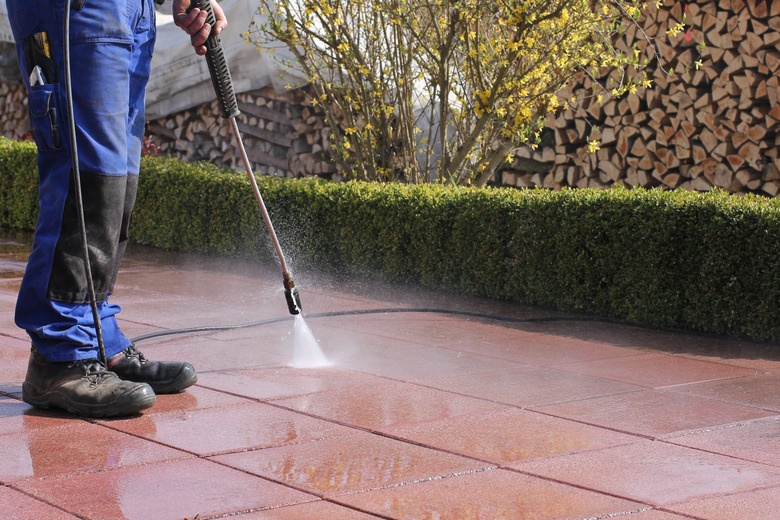How To Remove Paint Overspray From Pavers
We may receive a commission on purchases made from links.
There's one sure way to get paint overspray on pavers, and that's to fail to cover them before you use an airless sprayer to paint something nearby, such as a fence, a deck, or house siding. Fortunately, there is more than one way to get paint off, and the best method depends on the extent of the damage and the nature of the pavers.
The absolute best way to do the job is to use a power washer, but that isn't always practical. If the pavers are set in sand, the force of the water will blow the sand away. Some of the less-invasive but more time-consuming alternatives are to wash the paint off using soap and water or a solvent or use an abrasive tool, like a wire brush, to scrub it off.
Using a Power Washer to Remove Paint
Using a Power Washer to Remove Paint
For a tough job like removing paint, you need a fairly powerful power washer, such as a gas-powered model that can develop at least 3,000 psi. You also need to use the right nozzle; one with a very narrow spray pattern will damage the pavers, while one with a spray pattern that's too wide will be ineffectual. A 15-degree nozzle (the yellow one) is the perfect choice for extensive paint removal, but if there is just a small amount of overspray, a 25-degree nozzle (the green one) will do the job while being less intrusive.
Keep the wand of the power washer at a low angle while you work to protect the pavers and make the job go quicker. Avoid gouging the pavers by keeping the nozzle at least 6 inches away from the surface. If there's a garden nearby, try to spray away from it to avoid getting flecks of paint in the garden soil and on the plants.
Washing Off Paint With a Solvent
Washing Off Paint With a Solvent
Overspray isn't always as difficult to remove as you expect; it tends to partially dry while it's flying through air and often adheres weakly to surfaces when it lands. Sometimes, all it takes to get it off — especially if it's fresh — is a solution of soap and water and a rag or push broom. If you aren't having luck with plain soap, you can strengthen the solution by adding trisodium phosphate (TSP) or a TSP substitute (1/2 cup per gallon of water). Wear gloves and goggles if you're going to come in contact with TSP because it's caustic.
If the paint is oil-based, soap or TSP and water may not emulsify it enough for you to wipe or brush it off. In that case, you may have to resort to a solvent, such as mineral spirits or — for really tough jobs — lacquer thinner. If the paint is latex-based, isopropyl alcohol is another solvent you can use to dissolve it. You're outside, so the fumes shouldn't bother you, but if they do, wear a respirator.
Scrubbing Off Paint With a Wire Brush
Scrubbing Off Paint With a Wire Brush
You might find advice on the internet to remove paint from pavers using a grinding wheel, and while that will undoubtedly work, it will damage the pavers. It's not a great way to do the job. If you have to resort to an abrasive tool, make it a wire brush. It will reach into the pores of the concrete or stone where the paint has settled and scrape it away.
Even with a wire brush, you may have problems removing dried overspray, so to make the job easier, soak the pavers with soap and water or a solvent before you scrub. Short of using a power washer, this is the most invasive method of removing paint, and it may lighten the pavers. You can scrub all of them if you want the surface to look uniform, but it's probably easier to wait a few months for the pavers you scrub to naturally darken by themselves.
